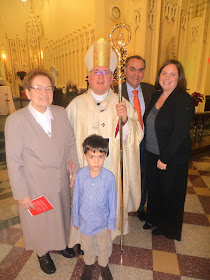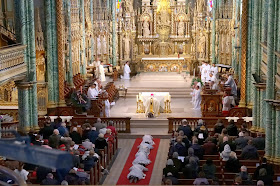Peter Faber (Favre) was St. Ignatius Loyola's first recruit. He was born on April 13, 1506, in the village of Villaret, Savoy. As a youth he shepherded his father's flock on the high pastures of the Alps and had no other education than what one receives at home. He was endowed, however, with an extraordinary memory; he could hear a sermon in the morning and then repeat it verbatim in the afternoon for his friends. He longed to go to school, but his family was too poor, and years later he wrote in his Memorial that in his sadness at not being able to study, he wept himself to sleep every night.
Peter's parents heard his weeping and finally acquiesced to his wishes and sent him in 1516 to a small school operated by the parish priest seven miles away. The 10-year-old quickly learned to read and write and the following year went to La Roche, a dozen miles away, where he remained until he went to the University of Paris in 1525.
Peter arrived in the French capital about October of that year and resided at the College of Sainte-Barbe, where his roommate was Francis Xavier. Francis had just come from Navarre and was the same age as Peter. Both gave themselves to their studies, beginning with philosophy and advancing to theology. In October 1529, they accepted another roommate, Ignatius Loyola, who had been in Paris for over a year, and of whom it was said that whoever came into contact with him invariably changed for the better.
Ignatius had difficulties with Greek so Peter tutored him in Aristotle. While Peter served as Ignatius' guide in academic matters, Ignatius served as Peter's guide in spiritual matters. Now in his mid-twenties, Peter was still undecided about his future. Should he be a lawyer? A teacher? A priest? A monk? It was while living in Paris that he learned of Ignatius' plan to follow Christ. This was what Peter needed to give direction to his life. Under Ignatius' influence he decided to become a priest, and shortly before his ordination Ignatius led him through the Spiritual Exercises for a period of thirty days….
On August 15, 1534, the feast of our Lady's Assumption, Ignatius and his six companions met in the crypt of the Chapel of Saint-Denis on Montmartre, and while Fr. Faber celebrated Mass—he was the only priest among them—each pronounced his vows….
When Ignatius returned to Spain for a period of convalescence, Fr. Faber was left in charge of the group. They left Paris in November 1536 and arrived in Venice in January of the following year to find that Ignatius had arrived before them. While waiting for the sailing season to the Holy Land to open, they worked in two of the city's hospitals. In March Ignatius sent Fr. Faber and the others to Rome to request Pope Paul III's approval of their proposed journey. Though His Holiness readily granted their request, he at the same time informed them that it was unlikely that the group would get there, because war with the Turks seemed imminent. Fr. Faber and companions returned to Venice; since the pope's fears proved correct, he and Ignatius directed their steps toward Rome in November to offer their services to the pope. The pope responded by appointing Fr. Faber to Rome's Sapienza University, where he lectured on theology and Scripture until May 1539.
[After a stay in Parma, Fr. Faber] was instructed to accompany Dr. Pedro Ortiz, Emperor Charles V's representative to the religious colloquy to be held between Catholics and Protestants at Worms in Germany. They arrived in Worms in late October, and though it was a Lutheran city Fr. Faber set about preaching, hearing confessions, and giving the Exercises. The colloquy was late in starting and when it did begin on January 14, 1541, it lasted only four days, for the emperor then transferred it to Ratisbon (today's Regensburg). Fr. Faber moved to Ratisbon in February and spent the next six months working among the Catholic faithful there. He was not directly involved in the theological discussions, but he followed them closely and sent letters to Fr. Ignatius describing the events taking place in the city.
Fr. Faber had more requests from priests, prelates, and princes to make the Spiritual Exercises than he himself could handle, and he wrote Fr. Ignatius that there was enough work in Ratisbon for ten more Jesuits. The colloquy's momentum, unfortunately, began to slow down and when it came time to discuss the Eucharist and Christ's real presence, a point bitterly disputed among the participants, the colloquy collapsed and the emperor's fond hope of unifying the Catholics and Protestants met a sad end….
In July 1544 Fr. Faber was assigned to Portugal at the request of King John III, who wanted him to pursue establishing the Society in that country. Fr. Faber spent the next two years in Portugal and Spain. Then in the spring of 1546, Pope Paul appointed him one of the papal theologians at the ecumenical council being held at Trent. Fr. Faber again had to set about traveling, but his health was greatly weakened from the frequent bouts of fever that he had suffered over the past years. He wanted to visit Fr. Ignatius before going to Trent in northern Italy so he sailed from Barcelona and made his way to Rome, arriving on July 17. He had not seen Ignatius for seven years and their greeting was as warm as the Italian sun above them. Before Fr. Faber had a chance to set out for Trent, the fever again attacked him.
Though only 40 years old, he knew that his end was coming and waited for it peacefully. On July 31 he made his confession, and on the morning of August 1 he heard Mass and received the last sacraments. That afternoon, while in the company of Fr. Ignatius, the gentle Fr. Faber went to God in the company of the angels to whom he was singularly devoted. Fr. Faber was buried in the church of Our Lady of the Way in Rome, but when the church of the Gesù was being erected in 1569 on the site of the former church, Fr. Faber’s remains and those of other early Jesuits were reinterred.
On September 5, 1872, Pope Pius IX, acknowledging the cult that had been paid to Peter Faber in his native Savoy, confirmed it by apostolic decree and declared that he was among the blessed in heaven. Pope Francis announced the canonization of Peter Faber on December 17, 2013. Peter Faber’s memorial is celebrated on August 2.
Prayer
Father, Lord of heaven and earth, who revealed yourself to Peter Faber, your humble servant, in prayer and in the service of his neighbour, grant that we may find you and love you in everything and in every person. Through our Lord Jesus Christ.
by Joseph N. Tylenda, SJ—Jesuit Saints and Martyrs, 2nd Edition © 1998 Loyola Press

.JPG)





















